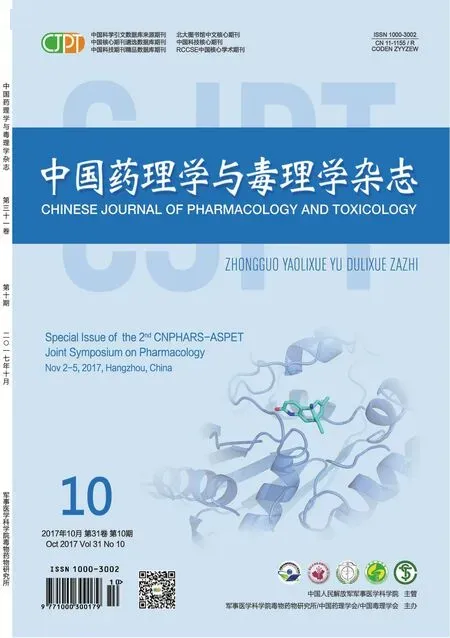TRPA1 channel mediates organophosphate-induced delayed neuropathy
Qiang DING,Sui FANG,Xue-qin CHEN,You-Xin WANG,Jian LI,Fu-yun TIAN,Xiang XU,Bernard ATTALI,Xin XIE,Zhao-bing GAO
(1.CAS Key Laboratory of Receptor Research,State Key Laboratory of Drug Research,Shanghai Institute of Materia Medica,Chinese Academy of Sciences,Shanghai 201203,China;2.University of Chinese Academy of Sciences,Beijing,China;3.Shanghai Leado Pharmatech Co.Ltd,Shanghai,China;4.Shanghai Key Laboratory of New Drug Design,School of Pharmacy,East China University of Science and Technology,Shanghai,China;5.Department of Physiology&Pharmacology,Sackler Faculty of Medicine,Tel Aviv University,Tel Aviv,Israel)
T1-9
TRPA1 channel mediates organophosphate-induced delayed neuropathy
Qiang DING1,2,Sui FANG1,2,Xue-qin CHEN1,2,You-Xin WANG3,Jian LI4,Fu-yun TIAN1,2,Xiang XU1,2,Bernard ATTALI5,Xin XIE1,2,Zhao-bing GAO1,2
(1.CAS Key Laboratory of Receptor Research,State Key Laboratory of Drug Research,Shanghai Institute of Materia Medica,Chinese Academy of Sciences,Shanghai 201203,China;2.University of Chinese Academy of Sciences,Beijing,China;3.Shanghai Leado Pharmatech Co.Ltd,Shanghai,China;4.Shanghai Key Laboratory of New Drug Design,School of Pharmacy,East China University of Science and Technology,Shanghai,China;5.Department of Physiology&Pharmacology,Sackler Faculty of Medicine,Tel Aviv University,Tel Aviv,Israel)
OBJECTIVEWe want to investigate the mechanism of organophosphate-induced delayed neuropathy(OPIDN)and find appropriate therapeutic medicine.OPIDN,often leads to pares?thesias,ataxia and paralysis,occurs in the late-stage of acute poisoning or after repeated exposures to organophosphate(OP)insecticides or nerve agents,and may contribute to the Gulf War Syndrome.METHODSFDSS Ca2+-influx assays,single-cell calcium imaging and patch-clamp electrophysiology were the major testing techniques.Transfected HEK293 cells and dorsal root ganglion(DRG)neurons were used to evaluate the effects of compounds.Wild type and trpa1 knockout mice and adult hyline brown hens were used to evaluate the neuropathological damages caused by the OPs.Transmission electron microscopy imaging was used to observe the nerve injuries ultrastructurally.High-throughput screen for TRPA1 inhibitors was accomplished by Ion Works Barracuda(IWB)automated electrophysiology assay.RESULTSTRPA1(Transient receptor potential cation channel,member A1)channel mediates OPIDN.A variety of OPs,exemplified by malathion,activates TRPA1 but not other neuronal TRP channels.Malathion increases the intracellular calcium levels and upregulates the excitability of mouse DRGneurons in vitro.Mice with repeated exposures to malathion also develop local tissue nerve injuries and pain-related behaviors,which resembles the early symptoms of OPIDN.Both the neuropathological changes and the nocifensive behaviors can be attenuated by treatment of TRPA1 antagonist HC030031 or abolished by knockout of Trpa1 gene.In the classic hens OPIDN model,malathion causes nerve injuries and ataxia to a similar level as the positive inducer tri-ortho-cresyl phosphate(TOCP),which also activates TRPA1 channel.Treatment with HC030031 reduces the damages caused by malathion or TOCP.Duloxetine and Ketotifen,two commercially available drugs exhibiting TRPA1 inhibitory activity,show neuroprotective effects against OPIDN and might be used in emergency situations.CONCLUSIONTRPA1 is the major mediator of OPIDN and targeting TRPA1 is an effective way for the treatment of OPIDN.
organophosphate;malathion;TOCP;organophosphate-induced delayed neuropathy;Transient receptor potential cation channel,member A1
The project supported by National Key Scientific Instrument&Equipment Development Program of China(2012YQ03026010);the Joint NSFC-ISF Research Program(8146114802);jointly funded by the National Natural Science Foundation of China and the Israel Science Foundation;the State Key Program of Basic Research of China(2013CB910604);and the National Natural Science Foundation of China(61327014 and 61175103)
Zhao-bing GAO,Tel:15021912788,E-mail:zbgao@simm.ac.cn
- 中國藥理學(xué)與毒理學(xué)雜志的其它文章
- Pharmacological study on traditional Chinese medicine and natural product in China
- GPCRomics:tissue and cellular GPCR expression identifies new therapeutic targets
- Direction of new drug research:soft regulation of inflammatory immune responses
- Targeting Gprotein-coupled receptors for the treatment of autoimmune diseases
- Arrestin mediated GPCR biased signaling and its application in new drug discovery
- Identification of a novel target for cancer and anti-fibrotic therapy

